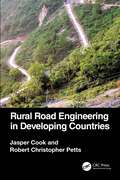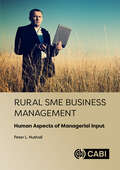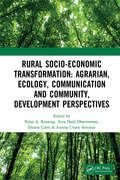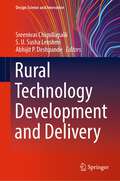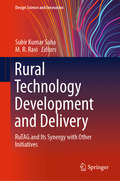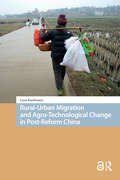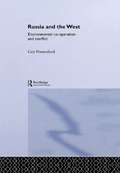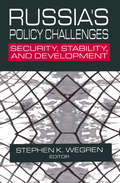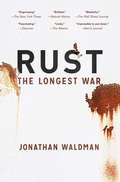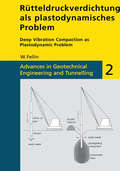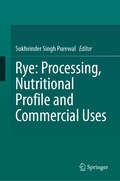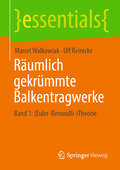- Table View
- List View
Rural Road Engineering in Developing Countries
by Jasper Cook Robert Christopher PettsRural Road Engineering in Developing Countries provides a comprehensive coverage of the planning, design, construction, and maintenance of rural roads in developing countries and emerging nations. It covers a wide range of technical and non-technical problems that may confront road engineers working in the developing world, focusing on rural roads which provide important links from villages and farms to markets and offer the public access to health, education, and other services essential for sustainable development. Most textbooks on road engineering are based on experience in industrialised countries with temperate climates or deal only with specific issues, with many aspects of the design and construction of roads in developing regions stemming from inappropriate research undertaken in Europe and the USA. These approaches are frequently unsuitable and unsustainable for rural road network environments, particularly in low to middle income countries. This book takes on board a more recent research and application focus on rural roads, integrating it for a broad range of readers to access current information on good practice for sustainable road engineering in developing countries. The book particularly suits transportation engineers, development professionals, and graduate students in civil engineering.
Rural SME Business Management: Human Aspects of Managerial Input
by Peter L NuthallThis book is about managerial ability and how it might be assessed and improved, and it focuses on rural Small and Medium Enterprises (SMEs). Traditionally, business studies have seldom covered the manager as a person and a decision maker in any great depth. Personnel management, production economics, financing, operations analysis techniques, etc. tend to be emphasized but the personal attributes of the decision makers have as much influence on success as the rules of good decision making. This book aims to correct this imbalance. The human characteristics of managers that define how a manager operates are explored, as are their impact on managerial ability. The details of the competencies a manager must possess are also presented and discussed as well as potential detracting biases. The book concludes with methods and techniques covering personal characteristic changes and associated managerial improvement. The concepts and conclusions of this book are all based on a body of research, excerpts of which are quoted in the text, drawn from the rich sources available in the international literature. Case studies describing successful managers and management advisors are used throughout. · First book which specifically focuses on human factors and decision making for SME managers. · Introduces new research specifically on the quantification of intuition, the primary decision making method used in SMEs. · Contains essential material required by researchers of decision making processes, business studies teachers, and extension workers from the world of SME business.
Rural Socio-Economic Transformation: Proceedings of the International Confernece on Rural Socio-Economic Transformation: Agrarian, Ecology, Communication and Community Development Perspectives (RUSET 2018), November 14-15, 2018, Bogor, West Java, Indonesia
by Rilus A. Kinseng, Arya Hadi Dharmawan, Djuara Lubis, Annisa Utami SeminarMost of Indonesian population live in rural areas, and the majority of poor people also live in rural areas, namely 13.47% in rural and 7.26 in urban. In the past decades, rural communities as well as the ecology have changed fundamentally. Many factors contribute to this transformation: development programs from the government as well as from private and NGOs; the diffusion of information technology; the development of transportation facilities; the rise of education and health levels, interaction with "outsiders", and so on. A main driving factor for rural development has been agrarian liberalization. This can be seen in the development of transnational plantations, which trigger land grab and rise of land demand. Development trough liberalization also had a negative impact, since the development of modern and industrialized agriculture affected the environment, and the expansion of plantations caused changes in the agricultural systems of villages and the life orientation of local communities. Interventions in villages by private companies, intermediary institutions no doubt have brought a structural transformations in rural live: local institutions, livelihood systems, population structures, ecosystems, and relation to the land. Unfortunately, the social, economic, cultural, and ecological transformation of the rural community not always produces improvement of quality of life for the rural community. At the same time, information and data related to rural transformations are scarcely available at research institutions, universities, NGOs, private enterprises. Rural Socio-Economic Transformation: Agrarian, Ecology, Communication and Community, Development Perspectives discusses many aspects of the social, economic, cultural, and ecological transformation of rural life in Indonesia, and is of interest to academics and policy makers interested or involved in these areas.
Rural Technology Development and Delivery (Design Science and Innovation)
by Abhijit P. Deshpande Sreenivas Chigullapalli S. U. Susha LekshmiThis book comprises the proceedings of the 2nd international conference on Rural Technology Development and Delivery organized by Rural Technology Action group Indian Institute of Technology (IIT) Madras. The book highlights research on demand driven technologies and innovations, mostly on energy, environment, water resources, livelihood and smart technologies for the development of rural India. Spanning multi-disciplinary research aspects on rural technologies and development, this book would be useful for rural entrepreneurs, researchers, students and academic/R&D institutions for getting them involved in appropriate rural technology and development.
Rural Technology Development and Delivery: RuTAG and Its Synergy with Other Initiatives (Design Science and Innovation)
by Subir Kumar Saha M. R. RaviThis book comprises the proceedings of a rural technologies conference organised by the Rural Technology Action Group (RuTAG), which was conceptualized and initiated by Principal Scientific Adviser (PSA) to the Government of India R. Chidambaram in 2003–04. The book highlights case studies and research into providing science and technology interventions for the development of rural areas. Covering various aspects of research carried out in the area of rural technologies, it offers a valuable resource for researchers, professionals, and policymakers alike.
Rural-Urban Migration and Agro-Technological Change in Post-Reform China (New Mobilities in Asia)
by Lena KaufmannHow do rural Chinese households deal with the conflicting pressures of migrating into cities to work as well as staying at home to preserve their fields? This is particularly challenging for rice farmers, because paddy fields have to be cultivated continuously to retain their soil quality and value. Drawing on ethnographic fieldwork and written sources, Rural-Urban Migration and Agro-Technological Change in Post-Reform China describes farming households' strategic solutions to this predicament. It shows how, in light of rural-urban migration and agro-technological change, they manage to sustain both migration and farming. It innovatively conceives rural households as part of a larger farming community of practice that spans both staying and migrating household members and their material world. Focusing on one exemplary resource - paddy fields - it argues that socio-technical resources are key factors in understanding migration flows and migrant-home relations. Overall, this book provides rare insights into the rural side of migration and farmers' knowledge and agency.
Rushed to Judgment: Talk Radio, Persuasion, and American Political Behavior (Power, Conflict, and Democracy: American Politics Into the 21st Century)
by David BarkerConvenient, entertaining, and provocative, talk radio today is unapologetically ideological. Focusing on Rush Limbaugh—the medium's most influential talk show—Rushed to Judgment systematically examines the politics of persuasion at play on our nation's radio airwaves and asks a series of important questions. Does listening to talk radio change the way people think about politics, or are listeners' attitudes a function of the self-selecting nature of the audience? Does talk radio enhance understanding of public issues or serve as a breeding ground for misunderstanding? Can talk radio serve as an agent of deliberative democracy, spurring Americans to open, public debate? Or will talk radio only aggravate the divisive partisanship many Americans decry in poll after poll? The time is ripe to evaluate the effects of a medium whose influence has yet to be fully reckoned with.
Russell Jennings Manufacturing Company Trade Catalog, 1899
by Kenneth D. RobertsRussell Jennings was synonymous with drill bits and the 1899 catalog showswhy, with its beautifully illustrated and fully described presentation.,
Russia and the Information Revolution
by D. J. PetersonThis work, the result of a six-year study, sheds light on Russia's role in the global Information Revolution. It examines Russia's increasing reliance on information and communications technologies (IT) to improve its government institutions, modernize business and industry and stimulate economic growth, broaden information access, and enhance the quality of life for Russian people. The author examines Russia's emerging IT sector, how businesses in Russia are seeking to use IT to enhance productivity and profitability, the impact of IT on government, and the course of the Information Revolution in Russian society.
Russia and the West: Environmental Co-operation and Conflict (Environmental Politics)
by Geir HønnelandHønneland assesses current environmental discourses and applies this analysis to look at the relations between Russia and the West with regards to environment problems. It includes three in-depth case-studies on environmental problems, living marine resources, nuclear safety and air pollution.
Russia's Policy Challenges: Security, Stability and Development
by Stephen K. WegrenDesigned for use in courses on contemporary Russia, this volume explores Russia's policy dilemmas in three realms: international security, socio-political, and socio-economic. In each of these categories, Russia faces daunting problems, none of which is likely to be resolved quickly or easily. Yet, over the longer term, the extent to which policymakers are successful in dealing with these challenges will go far in determining Russia's future place in the world, how Russians will live, and what kind of country Russia becomes. Each expertly authored chapter outlines the nature of one major issue; traces it evolution and policy developments under the Yeltsin and Putin presidencies; and evaluates the effectiveness and prospects of efforts to come to grips with the challenge.
Russia's Posture in Space: Prospects for Europe (Studies in Space Policy #18)
by Marco Aliberti Ksenia LisitsynaThe book sheds new lights on the evolution of Russian space activities with a focus on their strategy of international cooperation. This analysis is carried out in relation to the evolution of the domestic and international dynamics that have been impacting the country’s direction in space, with the ultimate goal of providing an assessment on their impact for current and foreseeable Europe-Russia space relations. Russia has traditionally been one of the two main strategic partners for Europe in its space endeavor. Hitherto, long-standing cooperation has been nurtured between the two actors in various areas, from scientific research to space transportation and human spaceflight. In recent years, however, a number of endogenous and exogenous developments has triggered significant changes in Russia’s space posture. These changes are evident in the adjustment of Russia’s space policies and programmatic goals, in the restructuring of the domestic space industry as well as in the attitude towards international space partnerships.
Russian Coal in the Era of Climate Change: Why it Will Survive and Will Not Become a Bargaining Chip in Relations with the West?
by Nikita Lomagin Maxim Titov Irina Mironova Michael OshchepkovThe Russian coal sector today faces challenges in the form of global decarbonization, sanctions, and difficulties in retaining market access and competitiveness. This new market environment warrants an examination of what lessons can be drawn from the past tribulations of one of Russia’s most iconic and strategically important industries. This book analyzes the Russian coal industry developments in historical and political contexts, including those of energy transition. The key tenets of contemporary dialogue between Russia and those who advocate for a speedy energy transition to phase out coal are presented. The book addresses the question of the coal industry as a sacrifice for the sake of Russia’s rapprochement with the West. The contribution of this book, therefore, is filling the gap between two large research inquiries – climate change mitigation and energy transition on the one hand, and the existing large coal industry of a given country on the other.
Russian Roulette: The Sixties Crime Series (The\sixties Crime Ser. #4)
by Bernard KnightA classic murder mystery by acclaimed crime writer Bernard Knight, set in London and Moscow at the height of the Cold War. Simon Smith, an ex-Army man with a gift for languages, is drafted in by a shady businessman to do some ‘work’ in the USSR. Simon thinks it’ll be an easy job with an ample reward…but what with multiple murders, beautiful femmes fatale, and devious master criminals, it’s not as simple as he’d hoped! Meanwhile, the Russian detectives set to trail a suspected thief have all their expectations confounded… A thrilling tale of international politics and police work on the other side of the ‘Iron Curtain’.
Rust: The Longest War
by Jonathan WaldmanIt has been called "the great destroyer" and "the evil." The Pentagon refers to it as "the pervasive menace." It destroys cars, fells bridges, sinks ships, sparks house fires, and nearly brought down the Statue of Liberty. Rust costs America more than $400 billion per year--more than all other natural disasters combined.In a thrilling drama of man versus nature, journalist Jonathan Waldman travels from Key West, Florida, to Prudhoe Bay, Alaska, to meet the colorful and often reclusive people who are fighting our mightiest and unlikeliest enemy. He sneaks into an abandoned steelworks with a brave artist, and then he nearly gets kicked out of Ball Corporation's Can School. Across the Arctic, he follows a massive high-tech robot that hunts for rust in the Alaska pipeline. On a Florida film set he meets the Defense Department's rust ambassador, who reveals that the navy's number one foe isn't a foreign country but oxidation itself. At Home Depot's mother ship in Atlanta, he hunts unsuccessfully for rust products with the store's rust-products buyer--and then tracks down some snake-oil salesmen whose potions are not for sale at the Rust Store. Along the way, Waldman encounters flying pigs, Trekkies, decapitations, exploding Coke cans, rust boogers, and nerdy superheroes. The result is a fresh and often funny account of an overlooked engineering endeavor that is as compelling as it is grand, illuminating a hidden phenomenon that shapes the modern world. Rust affects everything from the design of our currency to the composition of our tap water, and it will determine the legacy we leave on this planet. This exploration of corrosion, and the incredible lengths we go to fight it, is narrative nonfiction at its very best--a fascinating and important subject, delivered with energy and wit.
Rusty Trusty Tractor
by Joy CowleyMicah's grandfather is convinced that his rusty, trusty, fifty-year-old tractor will make it through another haying season. But Mr. Hill of Hill's Tractor Sales is doing his best to sell him a brand-new tractor. He even wagers twenty jelly doughnuts that Grandpappy's old tractor will break down. Will Grandpappy buy a new tractor to replace his faithful old friend?This charming, multigenerational story offers a solid lesson in friendship and trust.
Ruth Run: A Novel
by Elizabeth Kaufman"A wildly fun and thrilling read in this age of digital theft, Ruth Run introduces us to an irresistible heroine and, in Elizabeth Kaufman, a scintillating new voice in contemporary fiction." —Maria Semple, author of Where&’d You Go, Bernadette and Today Will Be DifferentCybercrime leads to a cross-country pursuit as an ambitious, misfit young thief exploits a hacked microchip to rob banks, and learns too late that the wrong people have been watching herTwenty-six-year-old Ruth excels at microchip design but decides to get rich the old-fashioned way: robbing banks. She becomes a cybercriminal and devotes five years to siphoning more than $250 million out of the banking system using a hacked firewall chip that she created and only she knows how to access. Then one night an alarm goes off and she realizes she&’s been discovered.Five hours later she&’s on the run, chased across California and the West by a slew of government agents who see her as both a high-level national security threat and a potential intelligence asset. They&’ll catch her dead or alive—whatever it takes to make sure no one else discovers what she knows. Each of these men is obsessed with the woman he&’s hunting, certain he knows what makes her tick. But Ruth, always a step ahead, armed with her ironic wit and a reluctant dog, eludes their understanding; can she elude their capture, too?A nonstop oddball thriller for the age of digital theft, Ruth Run introduces an irresistible new heroine and a fantastic new voice in contemporary fiction.
Ruthenium in Catalysis
by Pierre H. Dixneuf Christian BruneauThe series Topics in Organometallic Chemistry presents critical overviews of research results in organometallic chemistry. As our understanding of organometallic structure, properties and mechanisms increases, new ways are opened for the design of organometallic compounds and reactions tailored to the needs of such diverse areas as organic synthesis, medical research, biology and materials science. Thus the scope of coverage includes a broad range of topics in pure and applied organometallic chemistry, where new breakthroughs are being achieved that are of significance to a larger scientific audience. The individual volumes of Topics in Organometallic Chemistry are thematic. Review articles are generally invited by the volume editors.
Ruthenium-Containing Polymers
by Andreas Winter Ulrich S. Schubert George R. NewkomeThis book presents the synthetic methodologies as well as the properties and potential usage of various ruthenium-containing materials. Starting from the first examples of 'ruthenopolymers' reported in the 1970s to the 3D architectures now synthesized, these materials have shown their importance far beyond fundamental polymer science. As well as highlighting the remarkable properties and versatile applications, this book also addresses a key question related to the applications of such heavy-metal-containing materials from the perspective of achieving a sustainable future. This book is of interest to both materials scientists and chemists in academia and industry.
Rutteldruckverdichtung Als Plastodynamisches Problem / Deep Vibration Compaction as Plastodynamic Problem
by W FellinVibroflotation is a method of ground improvement up to depths of 40 metres. It has been successfully used since 1936 but the major problem with this method is that in spite of the fact that it performs well, nobody can explain how it works. The techniques for checking the quality of the compaction during vibration are unreliable, making the method as a whole unquantifiable and unmeasurable. This title explores the problems surrounding the method, looking at deep compaction, plastodynamics and the Riemann problem amongst other issues, showing the reader what information from the movement of the vibration can be used as an additional quality control and to assess effectiveness.
Rwanda’s Land Tenure Reform: Non-existent to Best Practice
by Thierry Hoza NgogaRwanda's Land Tenure Reform: Non-existent to Best Practice provides a detailed account of how Rwanda managed to systematically demarcate and register all land, comprising over 10 million parcels within five years. This book: - Provides a detailed account of how Rwanda built a land administration system which is now internationally viewed as a model of success for implementing a complex land reform programme in the developing world. - Considers the ways in which land tenure reform has contributed to the country's development beyond the land sector. - Discusses how Rwanda's example can be followed by other countries wishing to embark on similar programmes of designing and implementing a nationwide land tenure regularisation programme. - Provides key strategic orientation to achieve a sustainable land administration programme. Offering a comprehensive narrative of the land tenure reform programme from inception to implementation, this book will be important reading for policy makers, land administration professionals, academics and development partners working in land administration and land tenure programmes in developing countries.
Rye: Genetics, Breeding, and Cultivation
by Rolf H. SchlegelOwing to its considerable winter hardiness, rye is a cereal that played a major role in the feeding of European populations throughout the Middle Ages. Recent data shows that rye is grown on about 5.4 million hectares, with a world production of approximately 13 million tons. While still an important bread food in many countries, rye produced for b
Rye: Processing, Nutritional Profile and Commercial Uses
by Sukhvinder Singh PurewalCereal grains are gaining interest from food manufacturers and pharmaceutical industries because of their health benefits. In the current day consumers are focusing on diets rich in nutrients and bioactive compounds and researchers are exploring the potential of different cereal grains. Cereal grain possesses a unique blend of macronutrients and micronutrients. Among different cereal grains (wheat, rye, oats, rice, barley and sorghum) rye possess higher amount of arabinoxylan. Rye is the only crop after wheat which possess a significant amount of gluten proteins, and is widely used in food industries throughout the world for the preparation of products such as bread, biscuits, rusk, flakes and beer. Scientific reports on rye considered it an important dietary source as it has well balanced amino acid profile as compared to wheat. Rye grains possess an array of bioactive compounds with antioxidant potential that may help in immunity boosting and countering age-related issues. Rye istraditionally used for the preparation of bread in Northern and Eastern Europe. As a staple food, bread is enjoyed by major part of population, making its quality is of utmost importance. Being an important part of dietary menu, bread should have high nutritional quality. Nutritional profile indicates that bread is a rich source of fibers, proteins along with macro and micronutrients. Rye is a dual-purpose crop used as food and feed and has the potential to be used for medicinal purpose as it is a good source of fibers and antioxidants. Further, starch isolated from rye grains can be utilized as excipient during tablet preparation. Rye starch-based coatings are useful in enhancing the shelf life of fresh cut fruits and whole fruits. After wheat, rye is the only cereal grain which possess gluten, meaning its flour can be used in the preparation of protein and fiber rich bakery products. Rye: Processing, Nutritional Profile and Commercial Uses discusses the physical parameters and health benefiting features of rye, exploring the chemistry of rye components, rye flour and starch properties and proteins and their extraction and industrial uses, antioxidant properties, fiber profile and health benefits, rye flour based important food products and effect of processing on nutritional profile. This is the first scientific text available specifically on rye grains and provides the latest information and updates. Rye's different components such as starch, protein, fiber, bioactive metabolites and their uses in food products are described in detail. Chapters focusing on the specific components of rye grains and their health benefits are included, making this the go-to source for researchers looking for a singular and comprehensive overview of this beneficial crop.
Räumlich gekrümmte Balkentragwerke: Band 1: (Euler-Bernoulli-)Theorie (essentials)
by Marcel Walkowiak Ulf ReinickeDieses äußerst kompakte Lehrbuch vermittelt ein vertieftes Verständnis der komplexen mechanischen Zusammenhänge räumlich gekrümmter Balkentragwerke, die über die elementaren Modelle des geraden Balkens hinausgehen. Es richtet sich somit an Studierende der Ingenieurwissenschaften in höheren Semestern, die bereits mit den grundlegenden Prinzipien der Stereostatik und der Festigkeitslehre vertraut sind, einschließlich der Bestimmung von Schnittgrößenverläufen sowie der Spannungs- und Verformungsanalyse.
S Is for Space: A Space ABC Primer
by Ashley Marie MirelesAn out-of-this-world ABC primer from astronaut to zenith and beyond!
